2024-08-01
7 min read

Cloudflare Radar is constantly monitoring the Internet for widespread disruptions. In mid-July, we published our Q2 2024 Internet Disruption Summary, and here we examine several recent noteworthy disruptions detected in the first month of Q3, including traffic anomalies observed in Bangladesh, Syria, Pakistan, and Venezuela.
Bangladesh
Violent student protests in Bangladesh against quotas in government jobs and rising unemployment rates led the government to order the nationwide shutdown of mobile Internet connectivity on July 18, reportedly to “ensure the security of citizens.” This government-directed shutdown ultimately became a near-complete Internet outage for the country, as broadband networks were taken offline as well. At a country level, Internet traffic in Bangladesh dropped to near zero just before 21:00 local time (15:00 UTC). Announced IP address space from the country dropped to near zero at that time as well, meaning that nearly every network in the country was disconnected from the Internet.


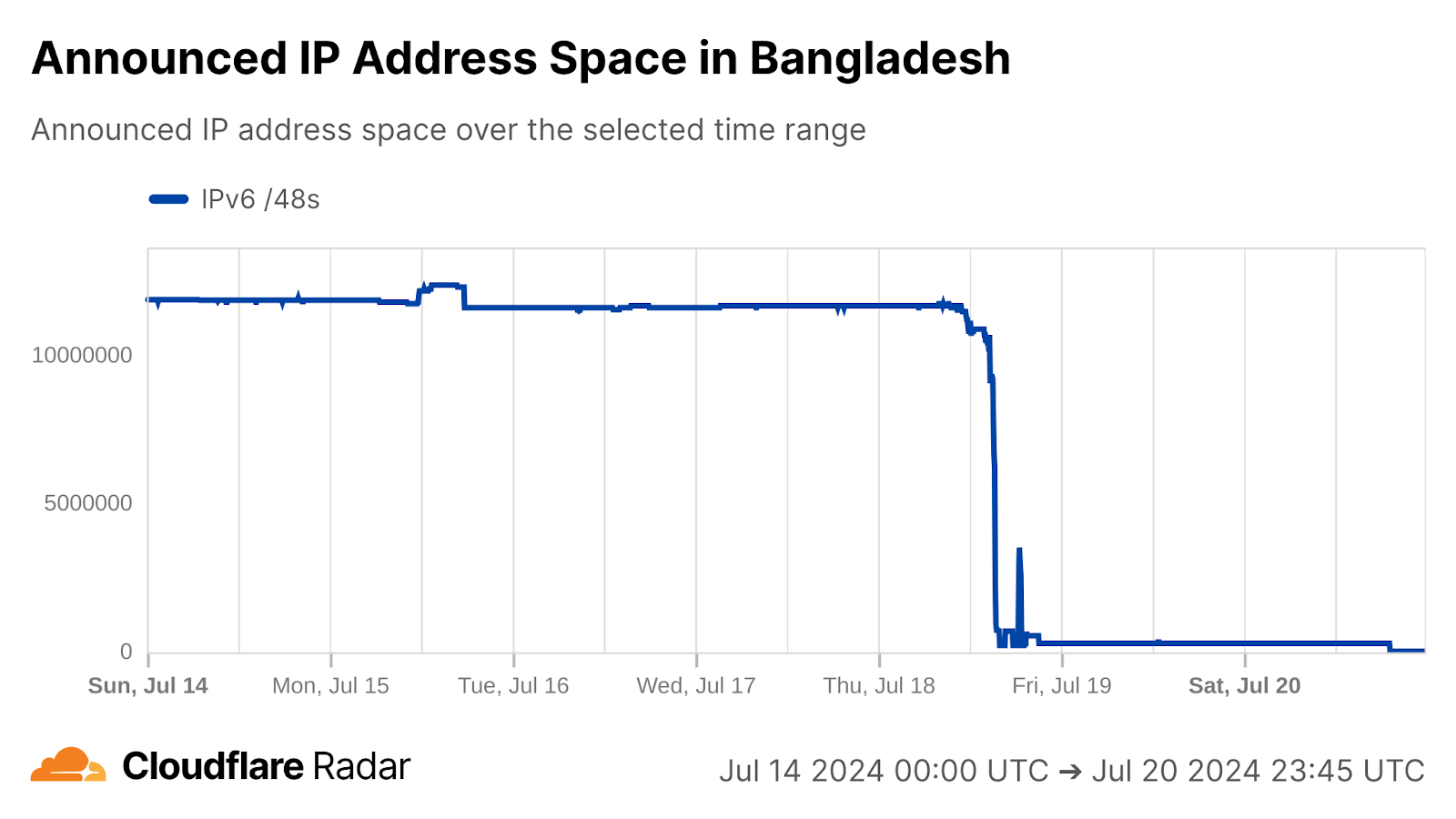
However, ahead of this nationwide shutdown, we observed outages across several Bangladeshi network providers, perhaps foreshadowing what was to come. At AS24389 (Grameenphone), a complete Internet outage started at 01:30 local time on July 18 (19:30 UTC on July 17), with a total loss of both Internet traffic and announced IP address space.
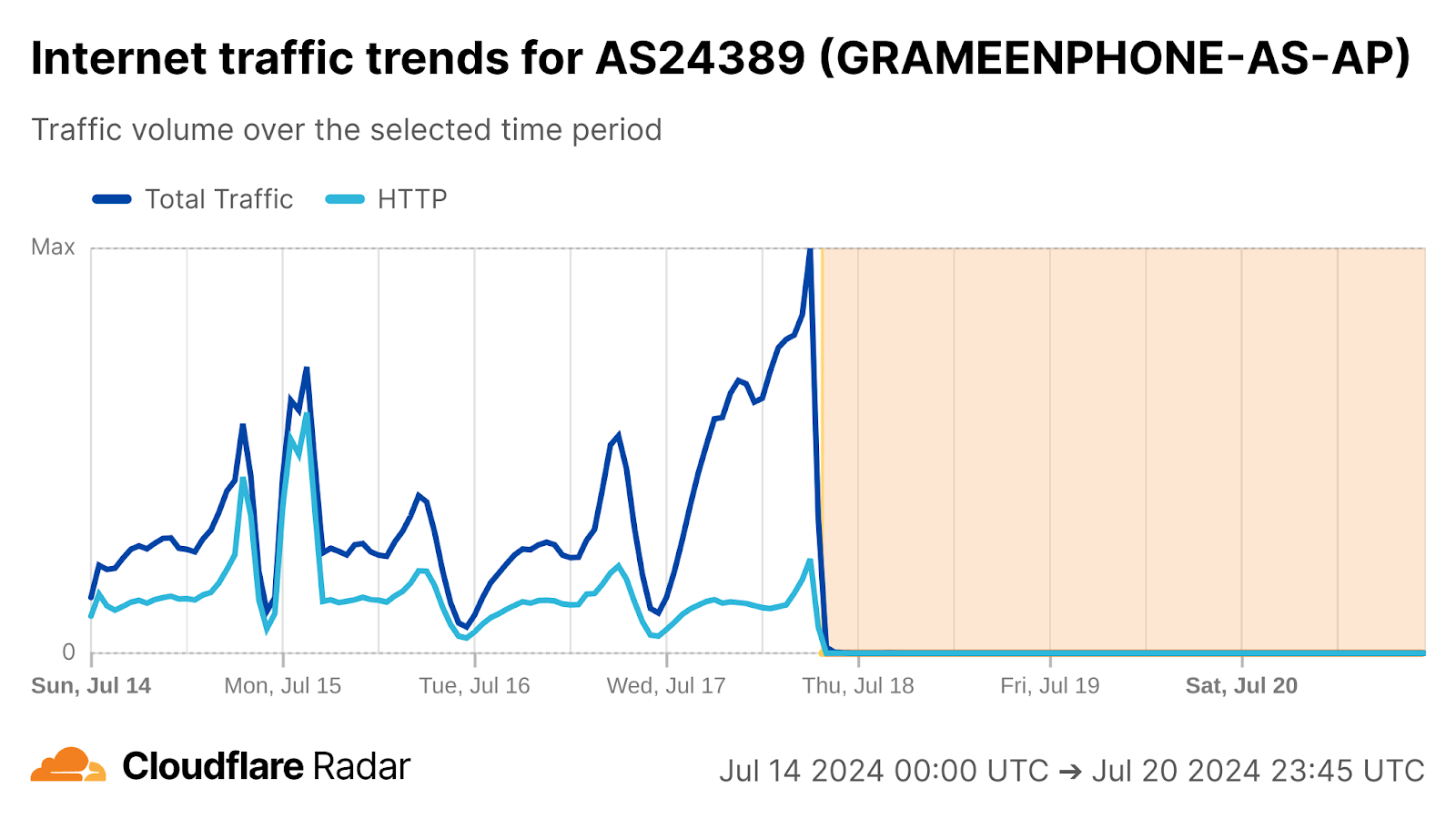
The outage at AS25245 (Banglalink) started at 02:15 local time on July 18 (20:15 UTC on July 17) as both Internet traffic and announced IP address space dropped to zero.
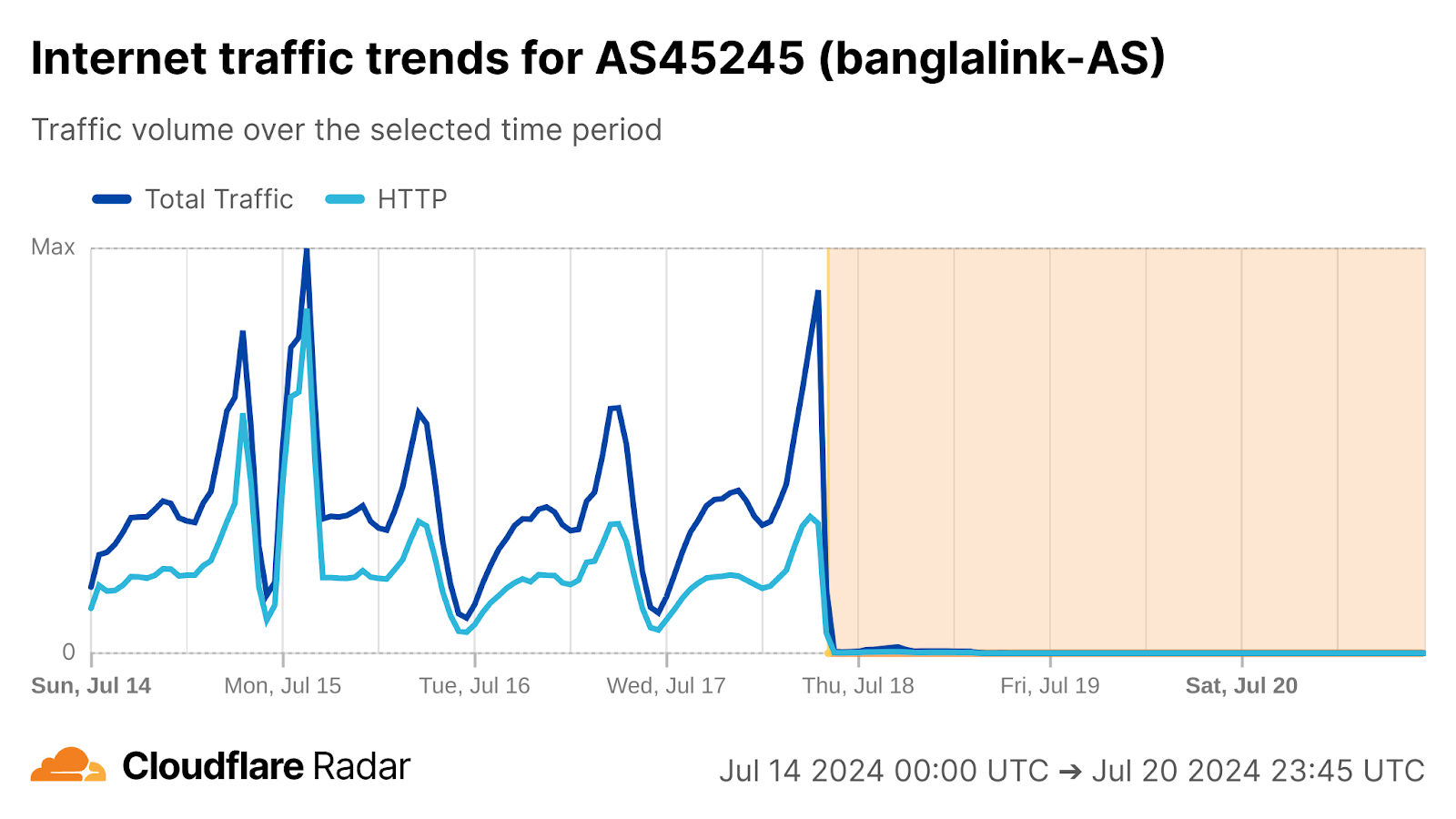
At AS24432 (Robi Axiata), an Internet outage was observed starting around 06:30 local time on July 18 (00:30 UTC), with both Internet traffic and announced IP address space disappearing at that time.
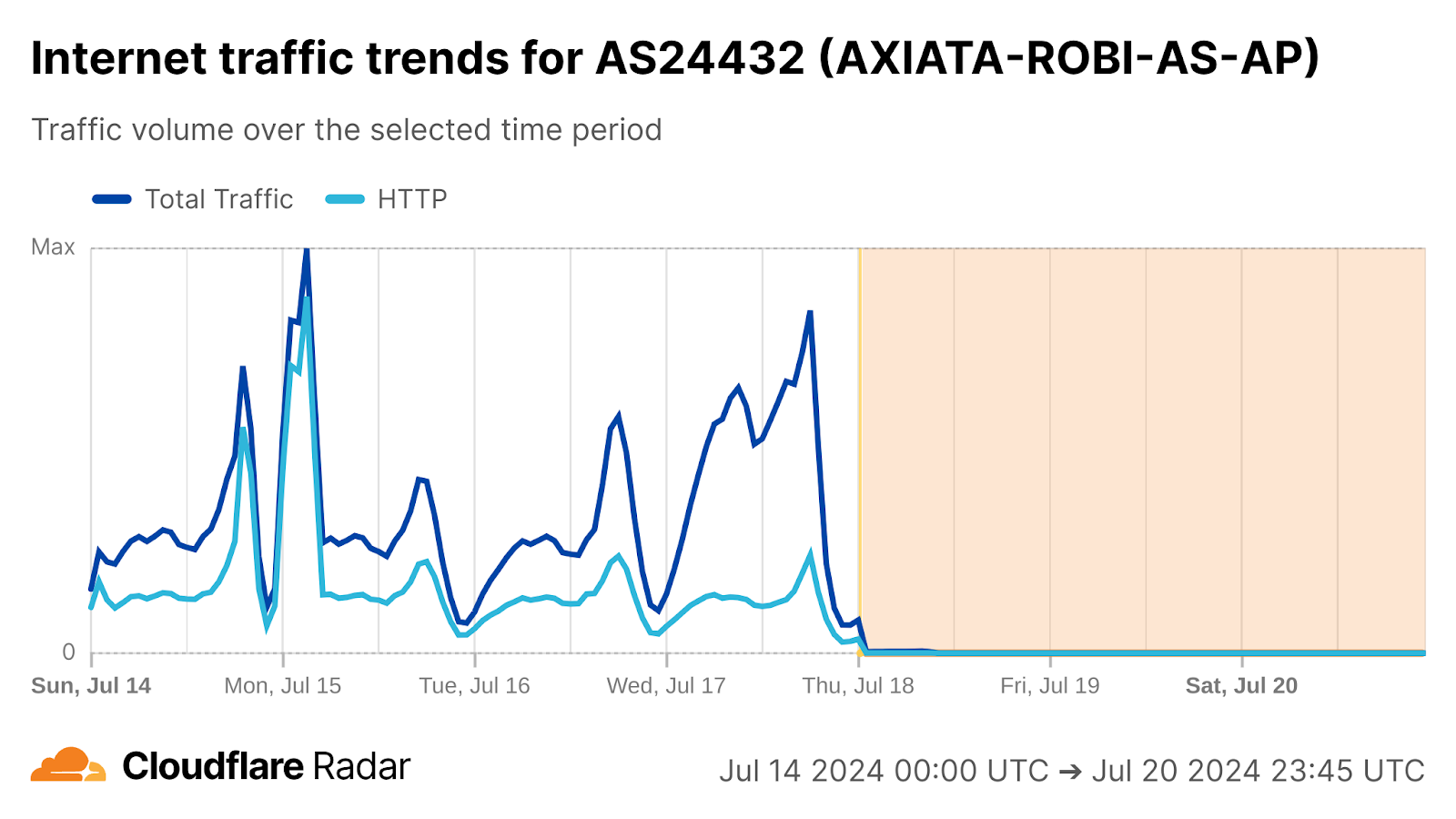
Internet traffic at AS58715 (Earth Telecommunication) began to fall at 18:00 local time on July 18 (12:00 UTC), reaching zero four hours later. Announced IP address space began to fall at 21:00 local time (15:00 UTC), and was completely gone by 21:25 local time (15:00 UTC).
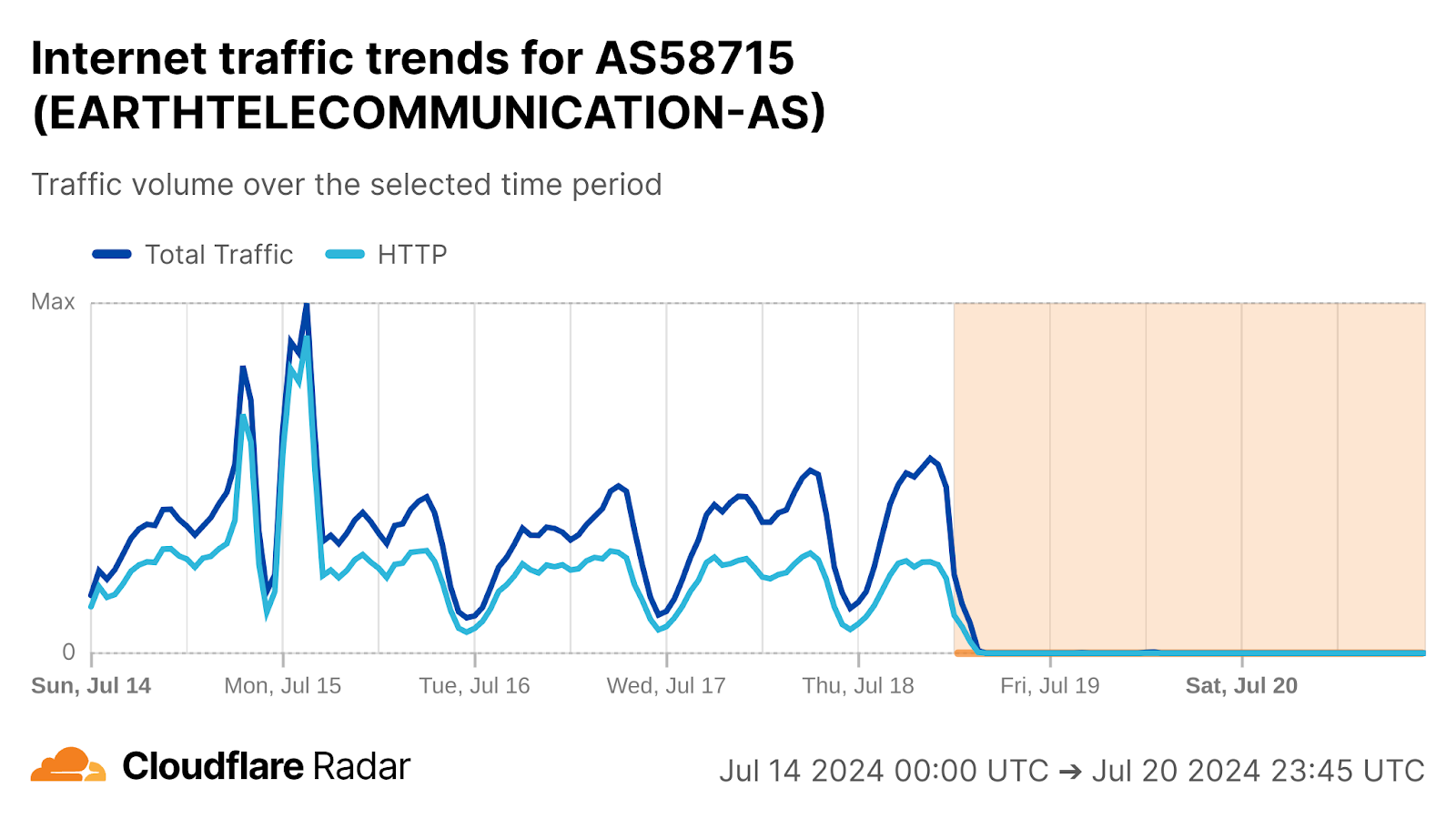
AS63526 (Carnival Internet) was one of the last to fall before the complete shutdown, losing traffic at 20:45 local time (14:45 UTC), and seeing all of its announced IP address space withdrawn over the following hour.
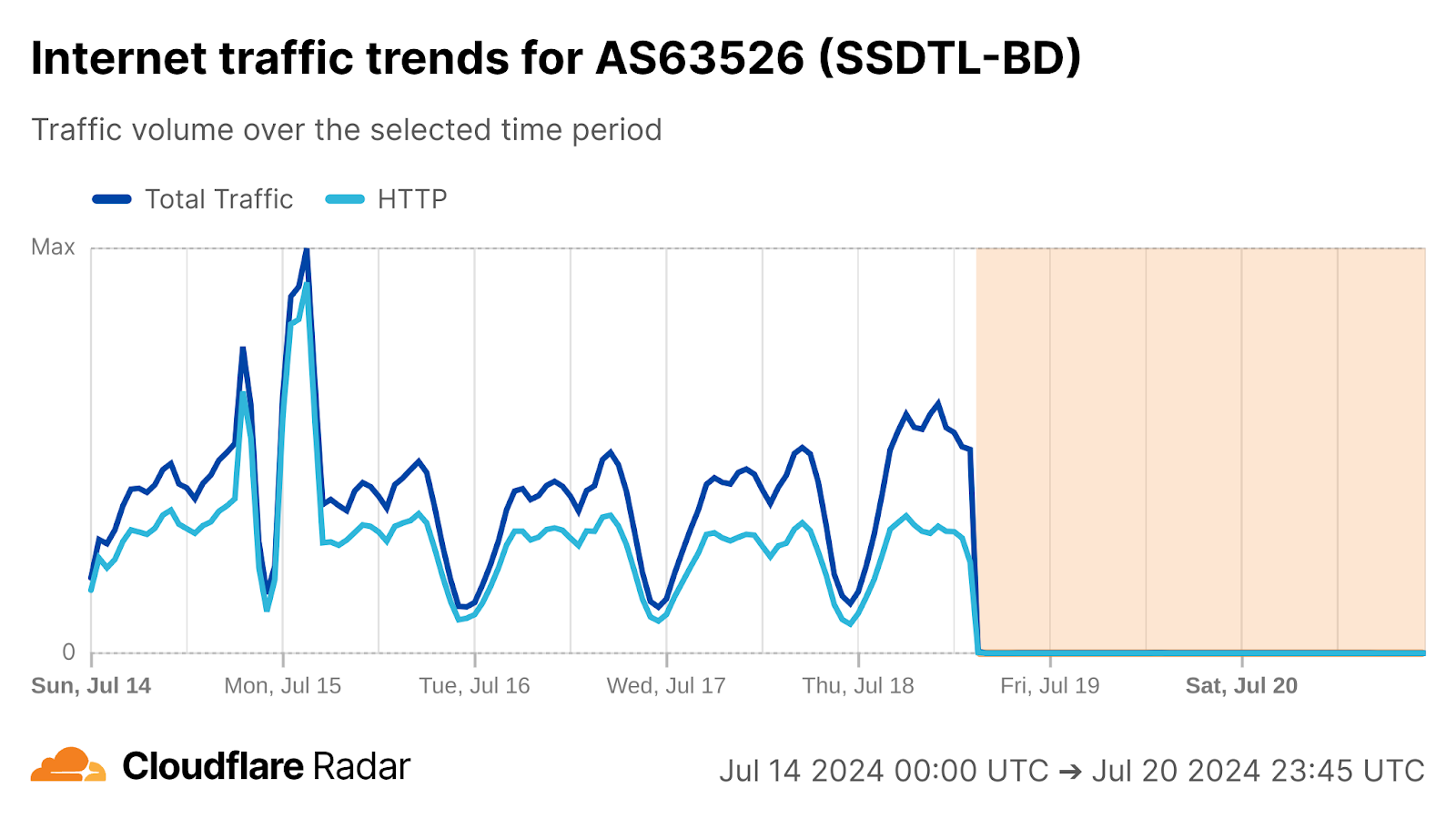
In the days before the shutdown, both median bandwidth and latency at a country level for Bangladesh were fairly stable. However, Cloudflare Radar’s Internet Quality measurements at a country level show a clear increase in median bandwidth and a concurrent drop in median latency, both likely due to the loss of measurements from mobile network providers as they disconnected from the Internet.
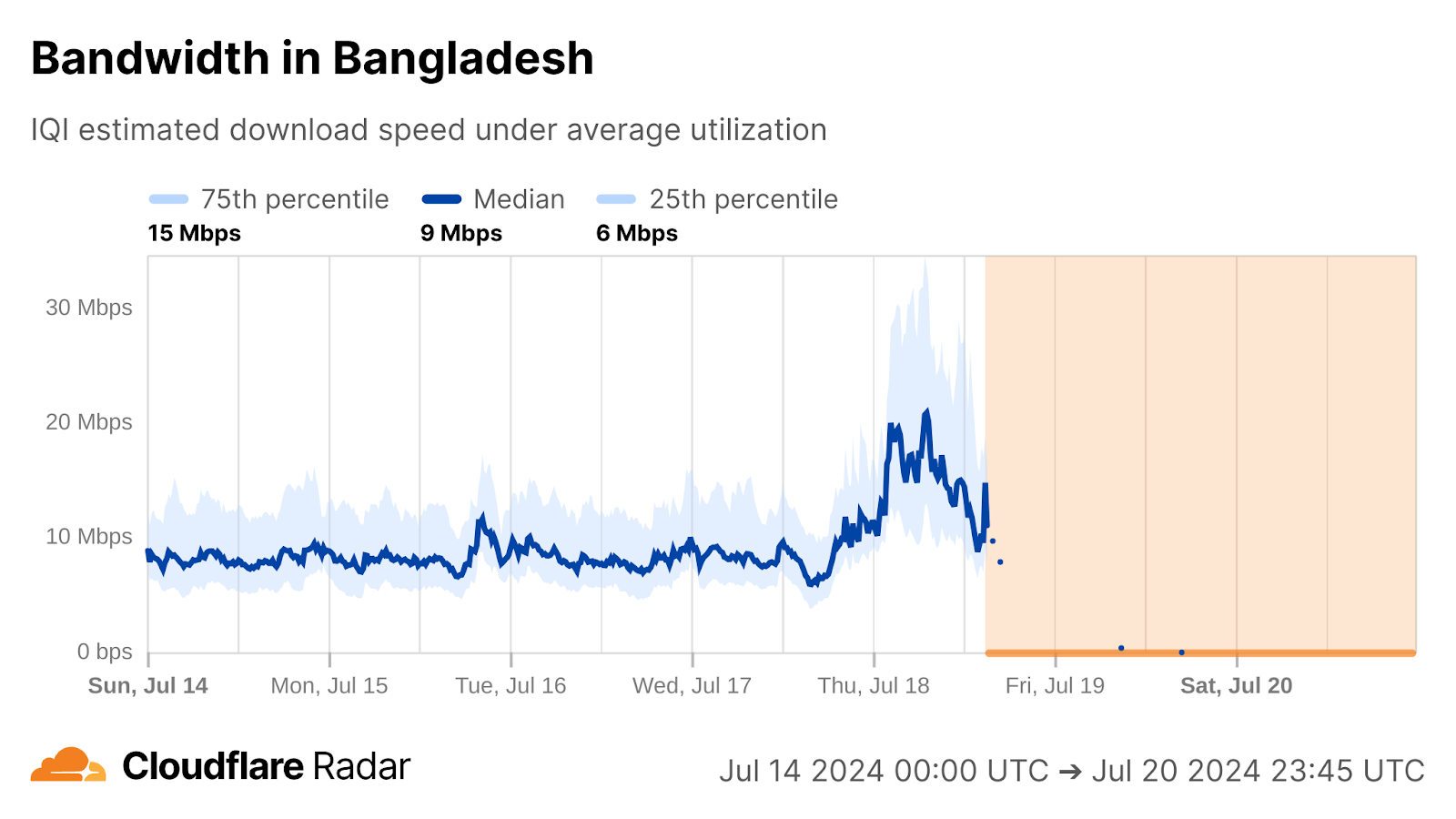
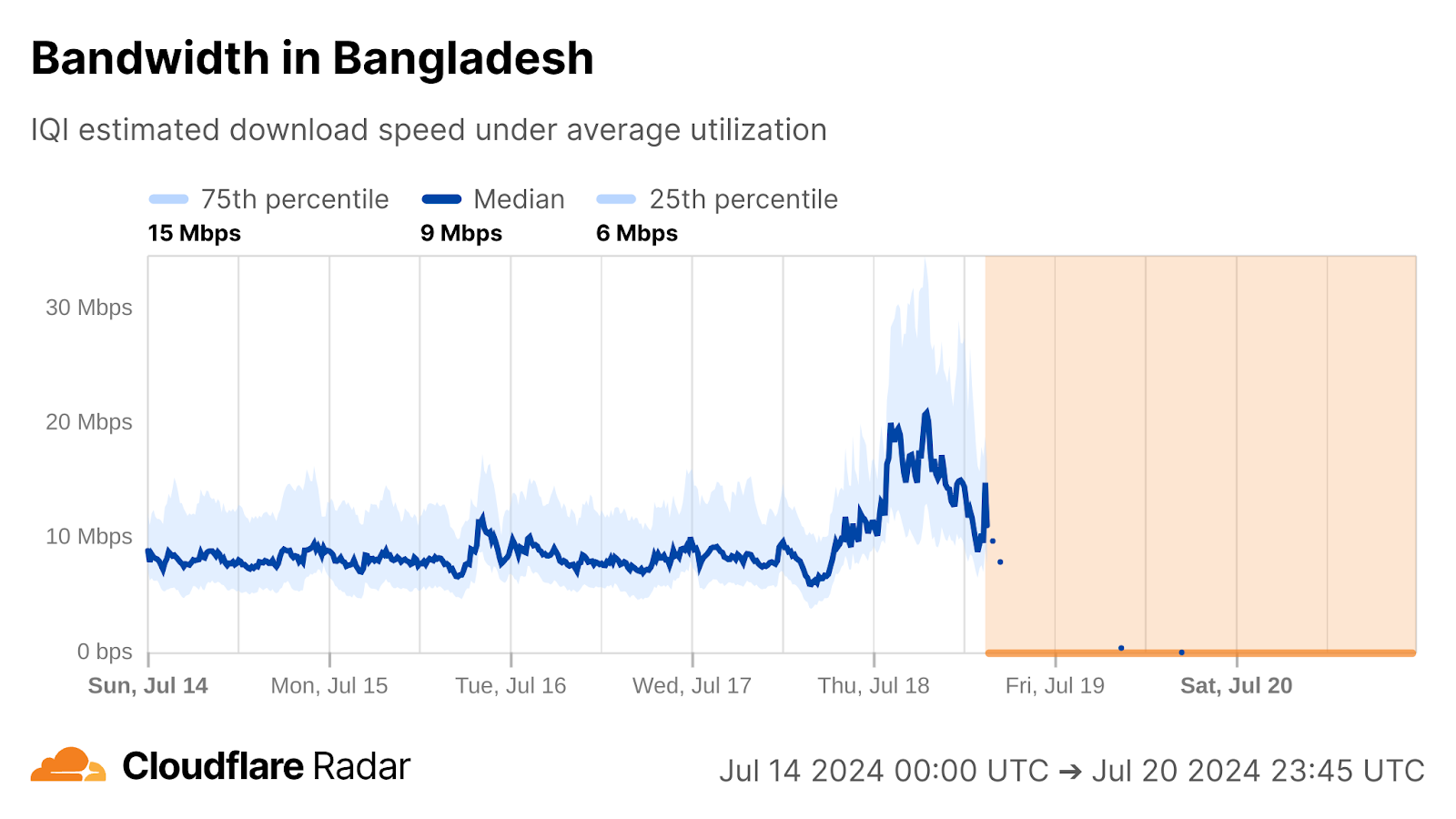
Five days after the full Internet shutdown started, broadband Internet services providers in Bangladesh began to restore connectivity on July 23. The initial restoration was characterized as a “trial run”, prioritizing banking, commercial sectors, technology firms, exporters, outsourcing providers and media outlets, according to the state minister for post, telecommunication and information technology. Announced IP address space began to increase around 19:00 local time (13:00 UTC), with traffic volumes beginning to trend upwards at that same time, as selected networks reconnected to the Internet.
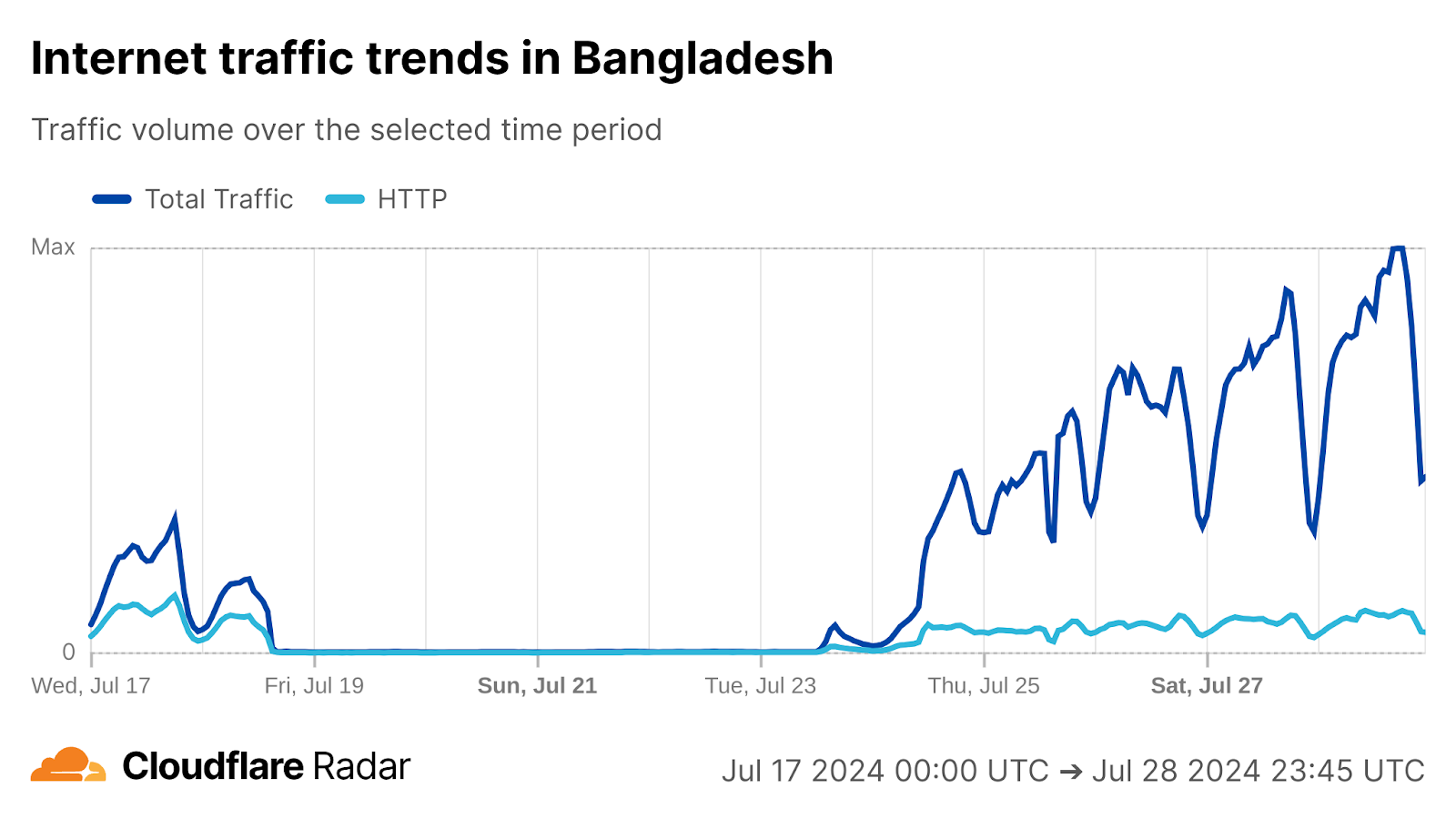
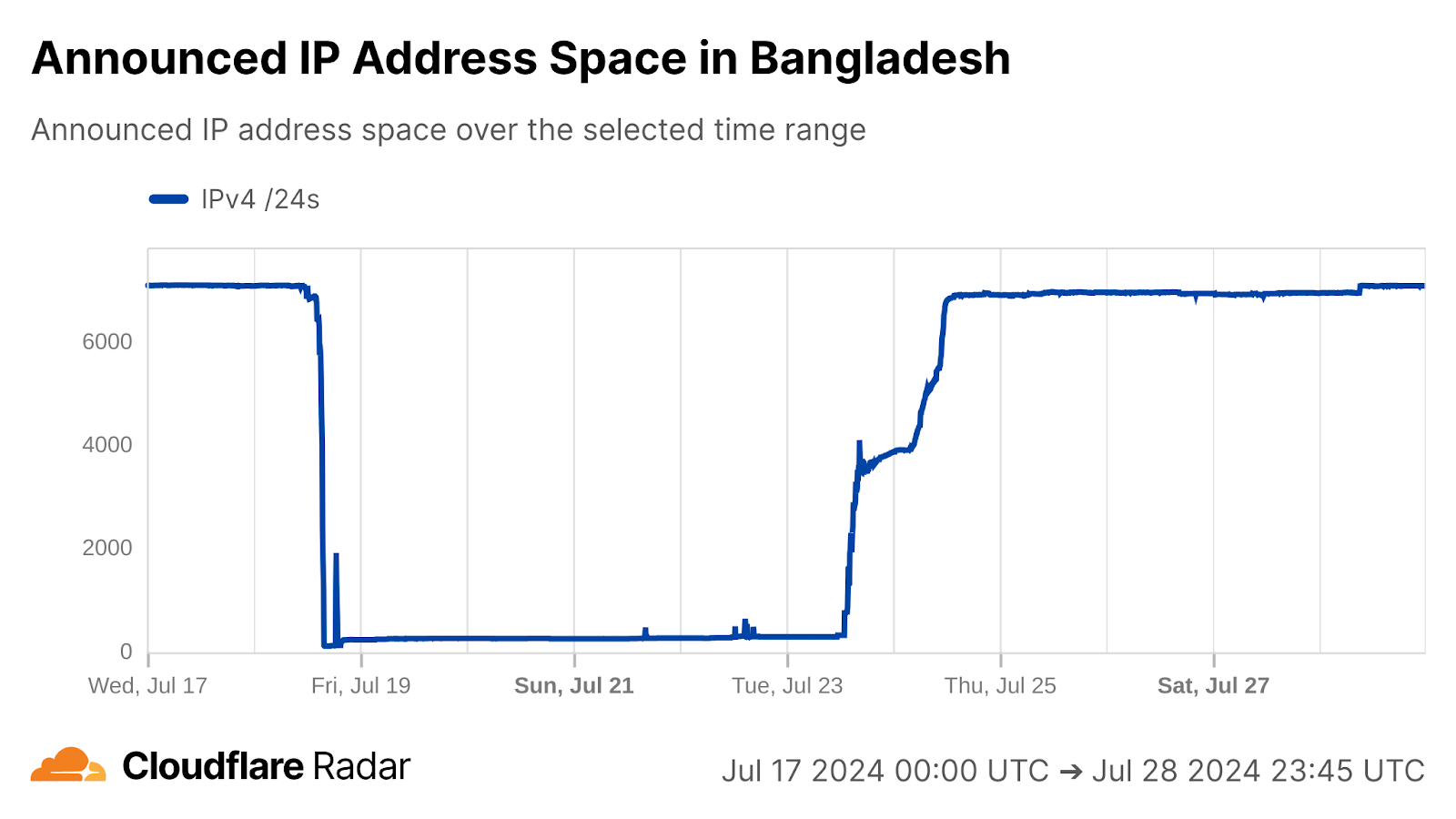
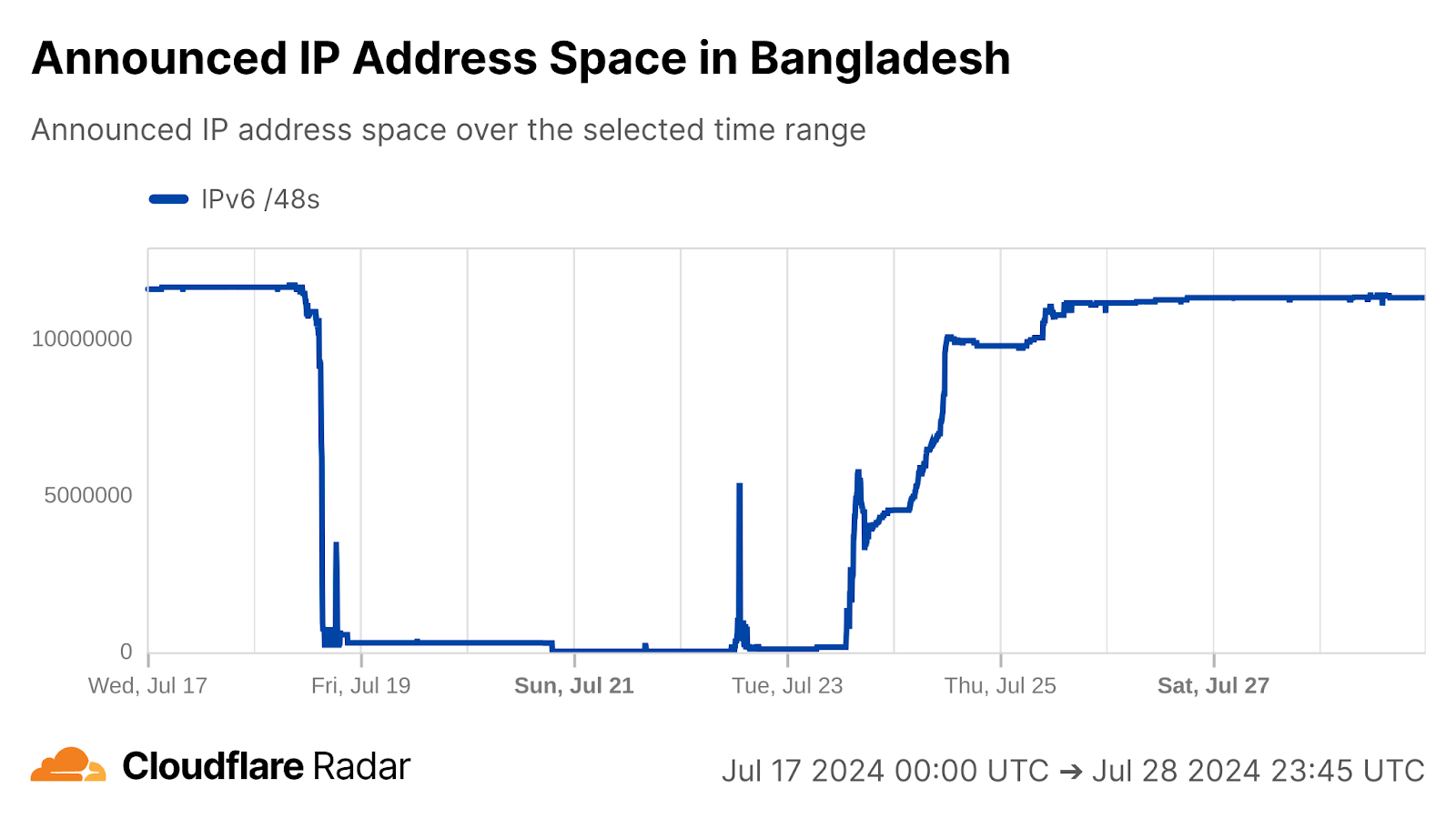
Looking at the network providers discussed above, traffic on AS63526 (Carnival Internet) and AS58715 (Earth Telecommunication) began to increase around 06:00 local time (00:00 UTC) on July 27, with these providers apparently included in a later phase of broadband restoration. However, traffic on mobile providers did not begin to recover until around 15:00 local time (09:00 UTC) on July 28, with AS24389 (Grameenphone), AS45245 (Banglalink), and AS24432 (Robi Axiata), all seeing traffic starting to grow significantly at or slightly after that time.
Syria
Unfortunately, Syria is no stranger to Internet shutdowns, as they occur yearly during nationwide exams, implemented with the intent of preventing cheating on those exams. Our recent blog post titled Exam-ining recent Internet shutdowns in Syria, Iraq, and Algeria examined the first round of 2024 exams, which took place between May 26 and June 13.
A second round of exams, and with them, multi-hour Internet shutdowns, began on July 25, and seen in the schedules below, published by Syrian Telecom on its Facebook page (English translation via Google Lens).

The Internet shutdowns implemented for the first four days of tests are clearly visible in the graph below, occurring on July 25, 28, 29, and 30.
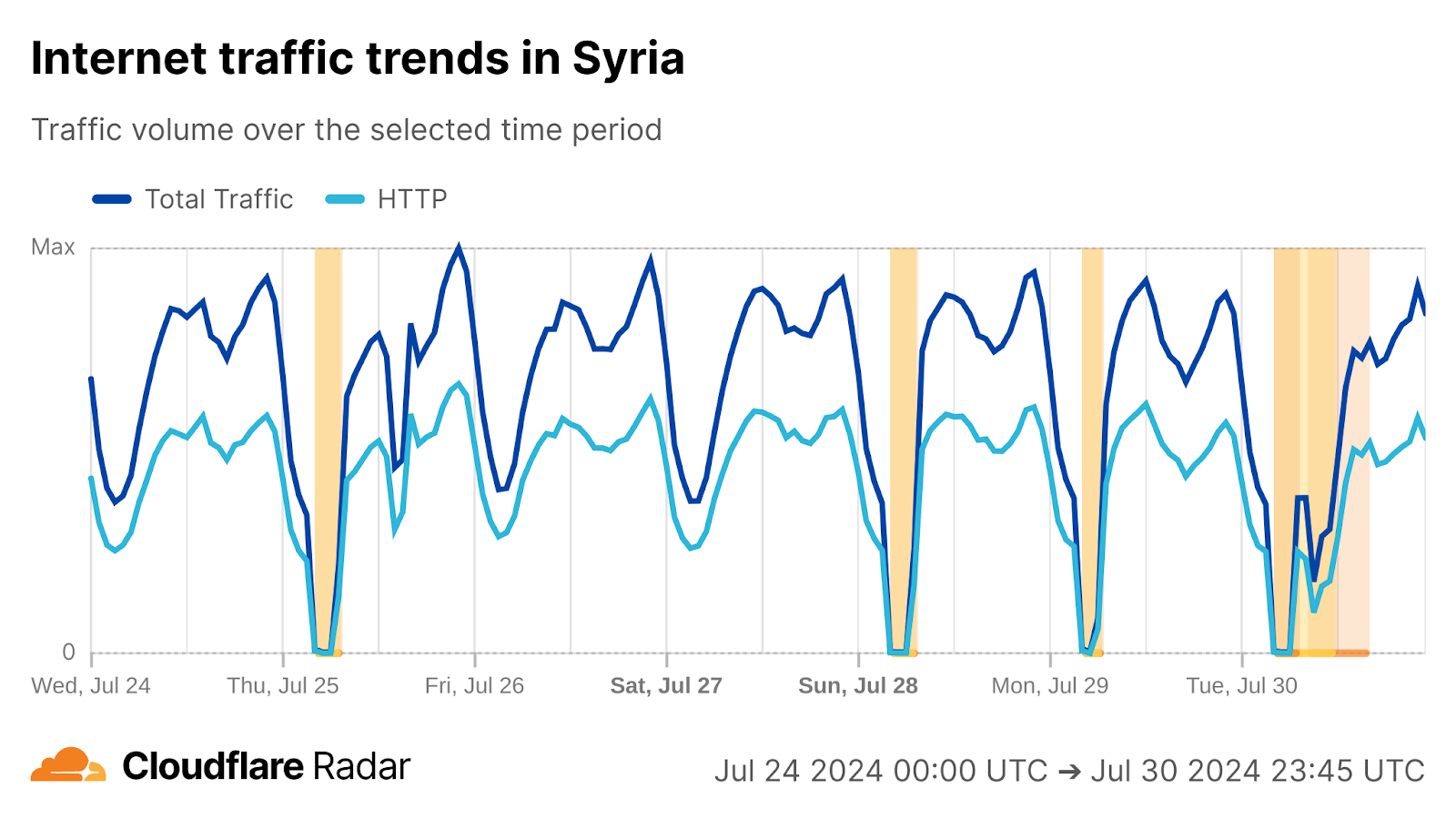
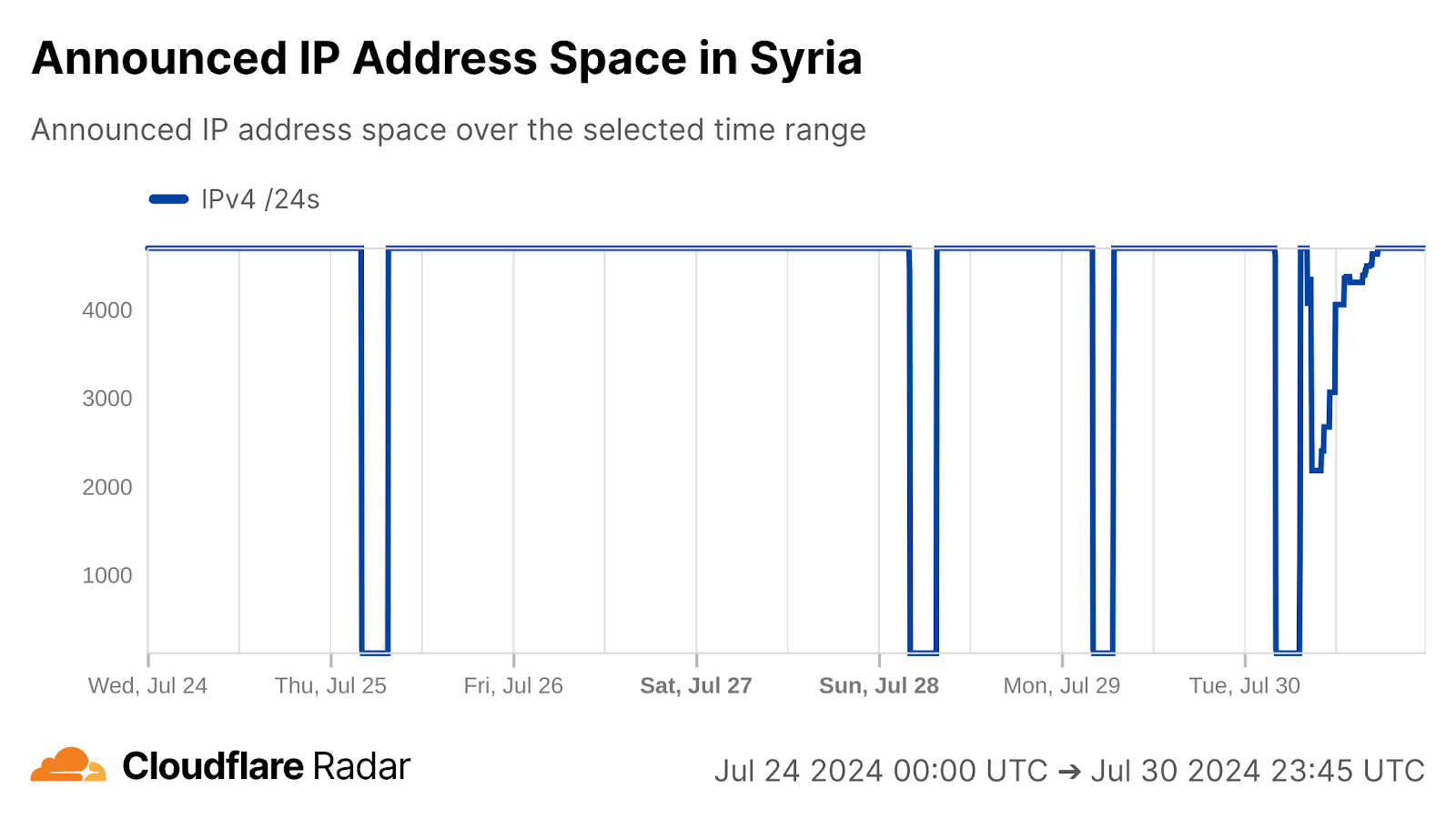
However, you will also note another disruption is visible in both Syria’s Internet traffic and announced IP address space shortly after the planned shutdown on July 30. According to a (translated) Facebook post from Syrian Telecom, “while performing regular maintenance on one of the air conditioners located in one of the technical halls [data centers], an explosion occurred, causing the Internet circuits to temporarily go out of service.” This issue resulted in a disruption lasting approximately eight hours, between 11:00 - 19:00 local time (08:00 - 16:00 UTC) seen in both traffic and announced IP address space graphs for AS29256 (Syrian Telecom).
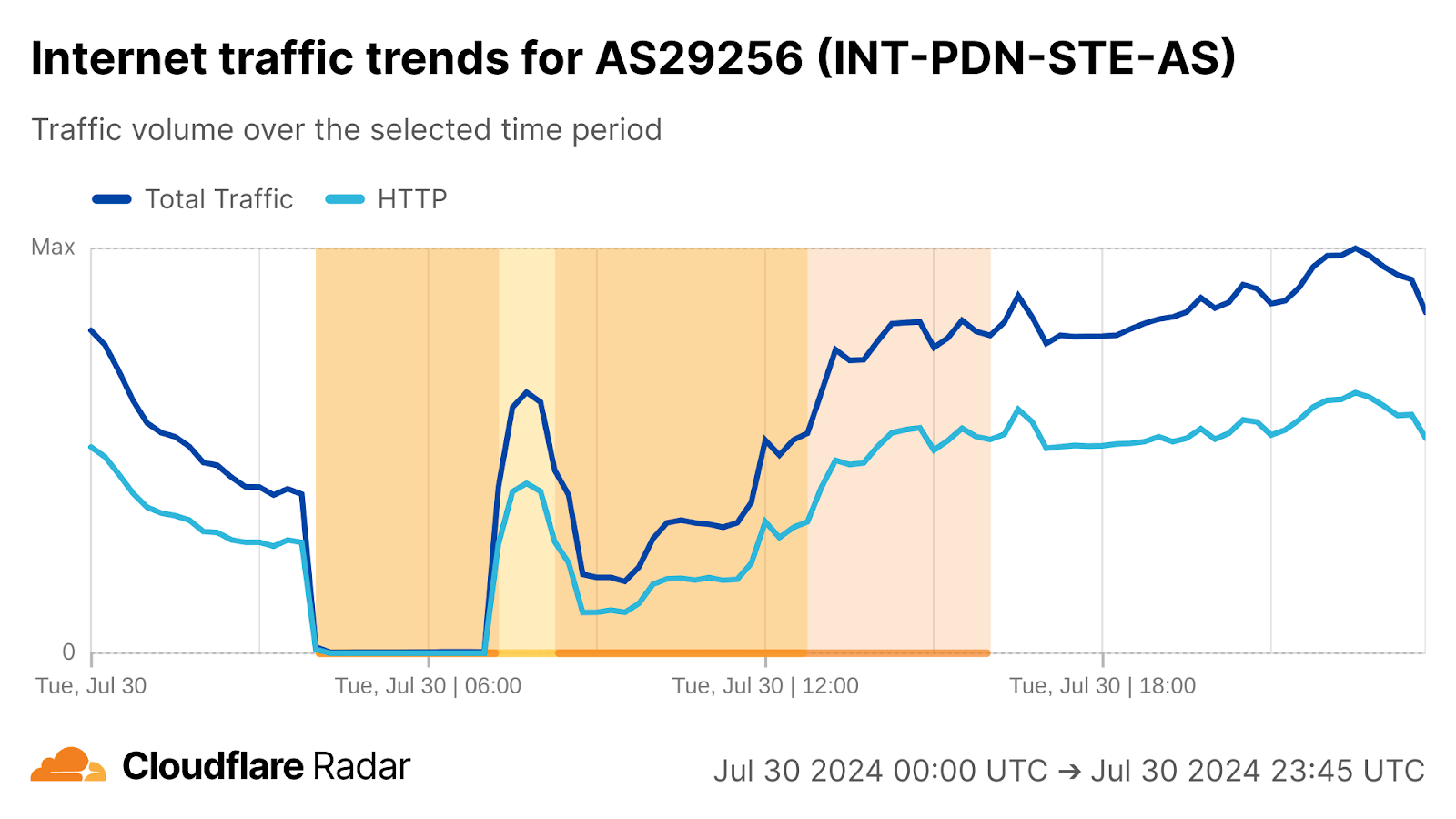
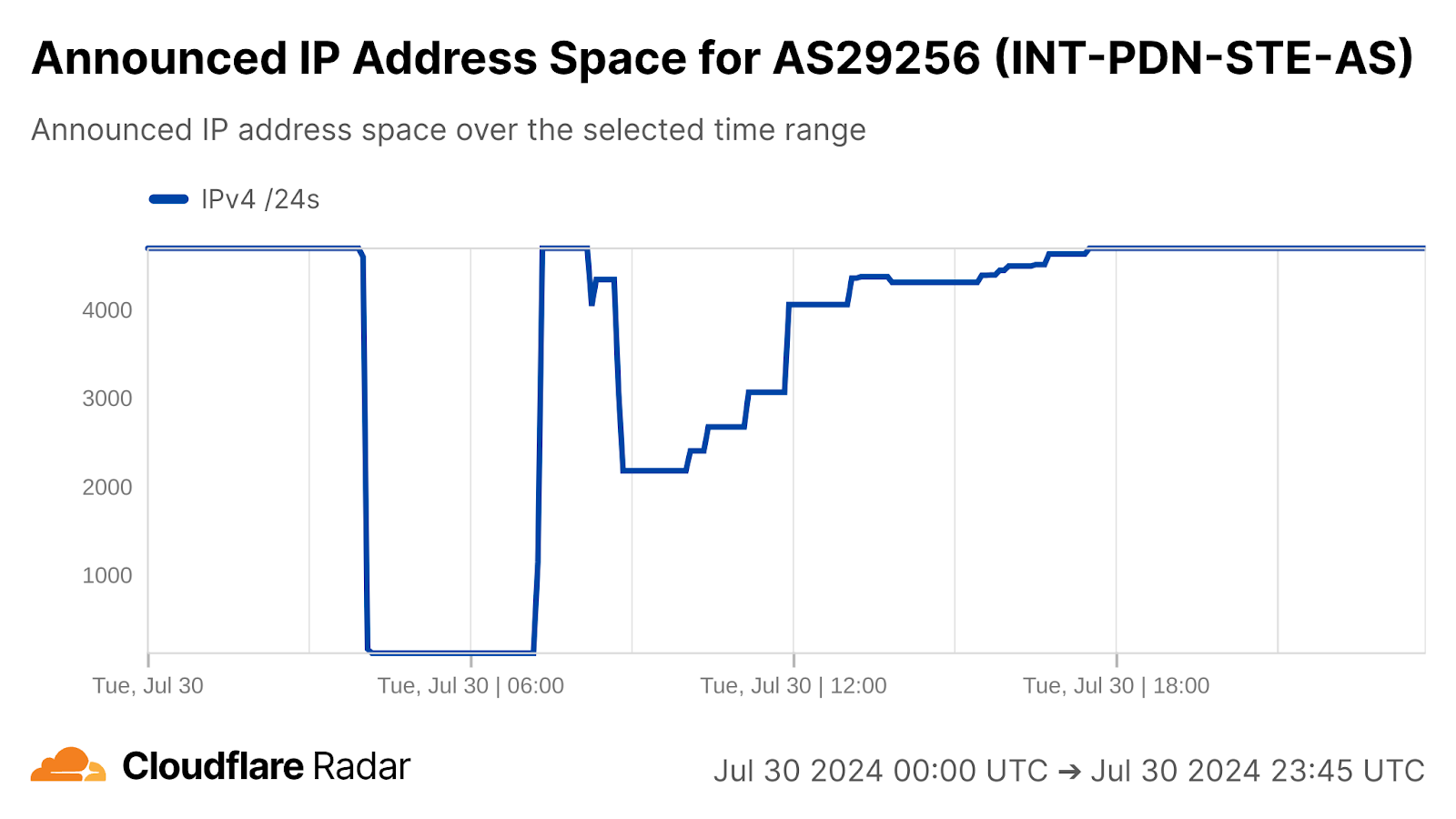
Pakistan
Closing out the month, on July 31, Pakistan experienced a wide-scale Internet disruption that lasted approximately two hours, between 13:30 - 15:30 local time (08:30 - 10:30 UTC). Traffic only dropped ~45% at a country level, but AS17557 (PTCL) experienced a near complete loss of traffic, while traffic at AS24499 (Telenor Pakistan) dropped nearly 90%. Together, the two network providers serve an estimated nine million users, and are among the top five Internet service providers in the country.
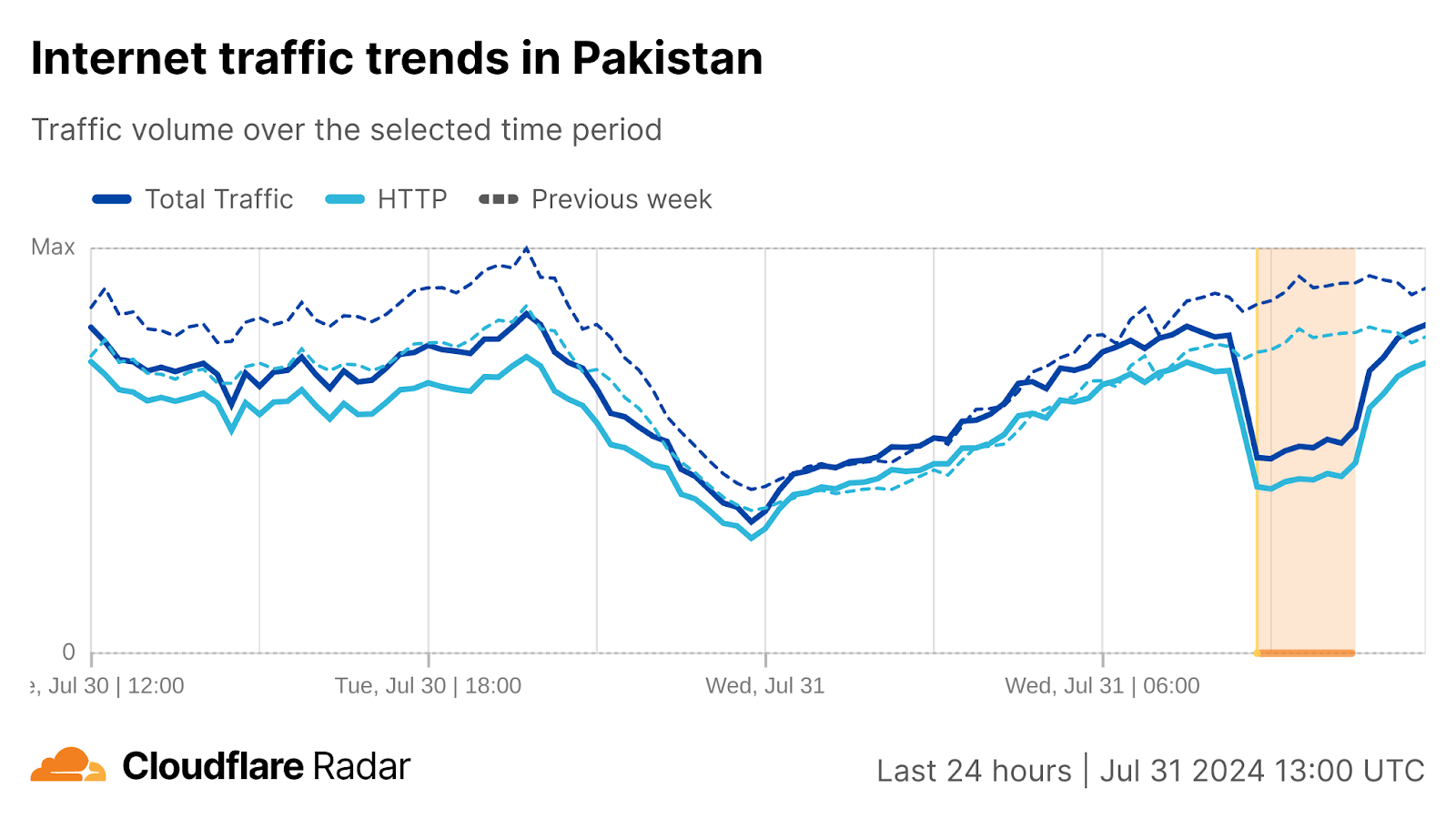
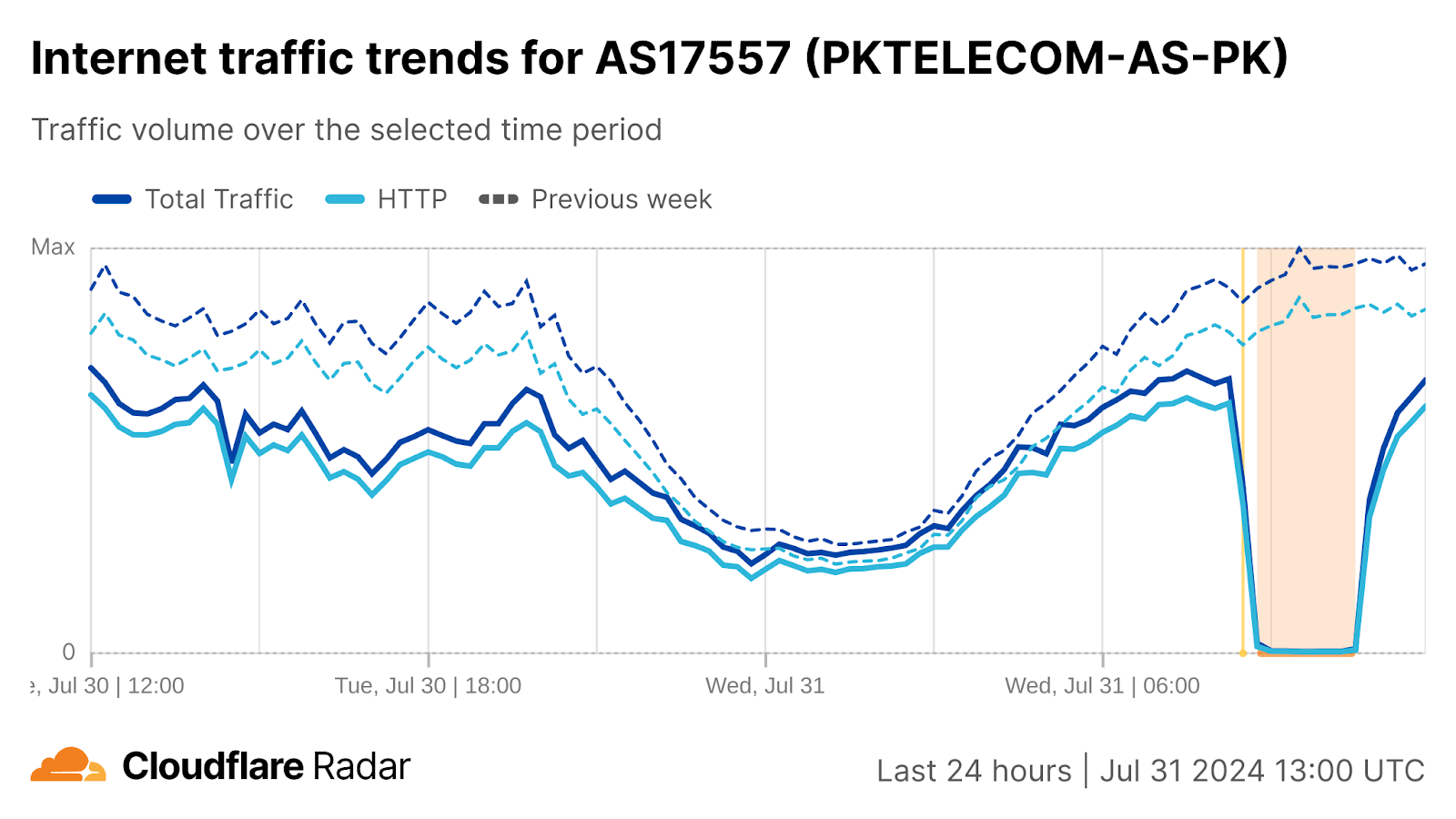
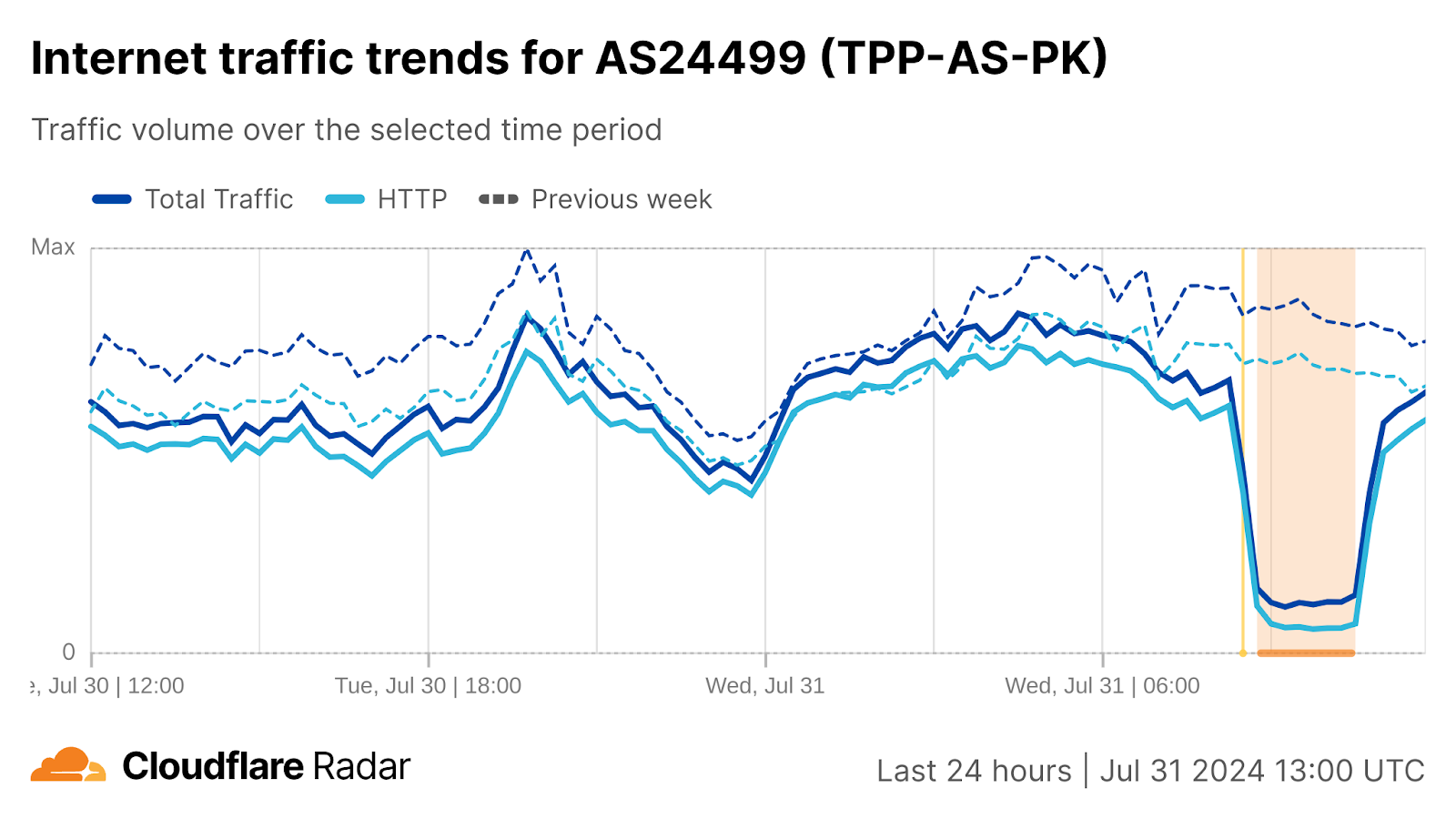
It was reported that the Pakistan Telecommunication Authority (PTA) attributed the disruptions to a technical glitch in the international submarine cable affecting the Pakistan Telecommunication Company Limited (PTCL) network. However, another published report noted “According to our sources, the government’s latest firewall edition to block the content was misconfigured, resulting in Internet connectivity disruption.” (Some additional information about the firewall can be found in this article.) The graphs below are from forthcoming TCP reset/timeout data on Cloudflare Radar, and show increased numbers of connections terminating immediately after the initial synchronization (SYN) packet used to establish new TCP connections (“Post SYN”) between 13:30 - 15:30 local time (08:30 - 10:30 UTC) on PTCL and Telenor Pakistan, coincident with the observed disruption. In other words, the rate of SYN packets arriving at Cloudflare was mostly consistent during the disruption, but there was a drop in other TCP packets, suggesting that the firewall explanation may be plausible.
A Facebook post from the Pakistan Telecommunication Authority (PTA) simply highlighted that the issue had been resolved, and that “The exact issue is being investigated by PTA to avoid such instances in future.”
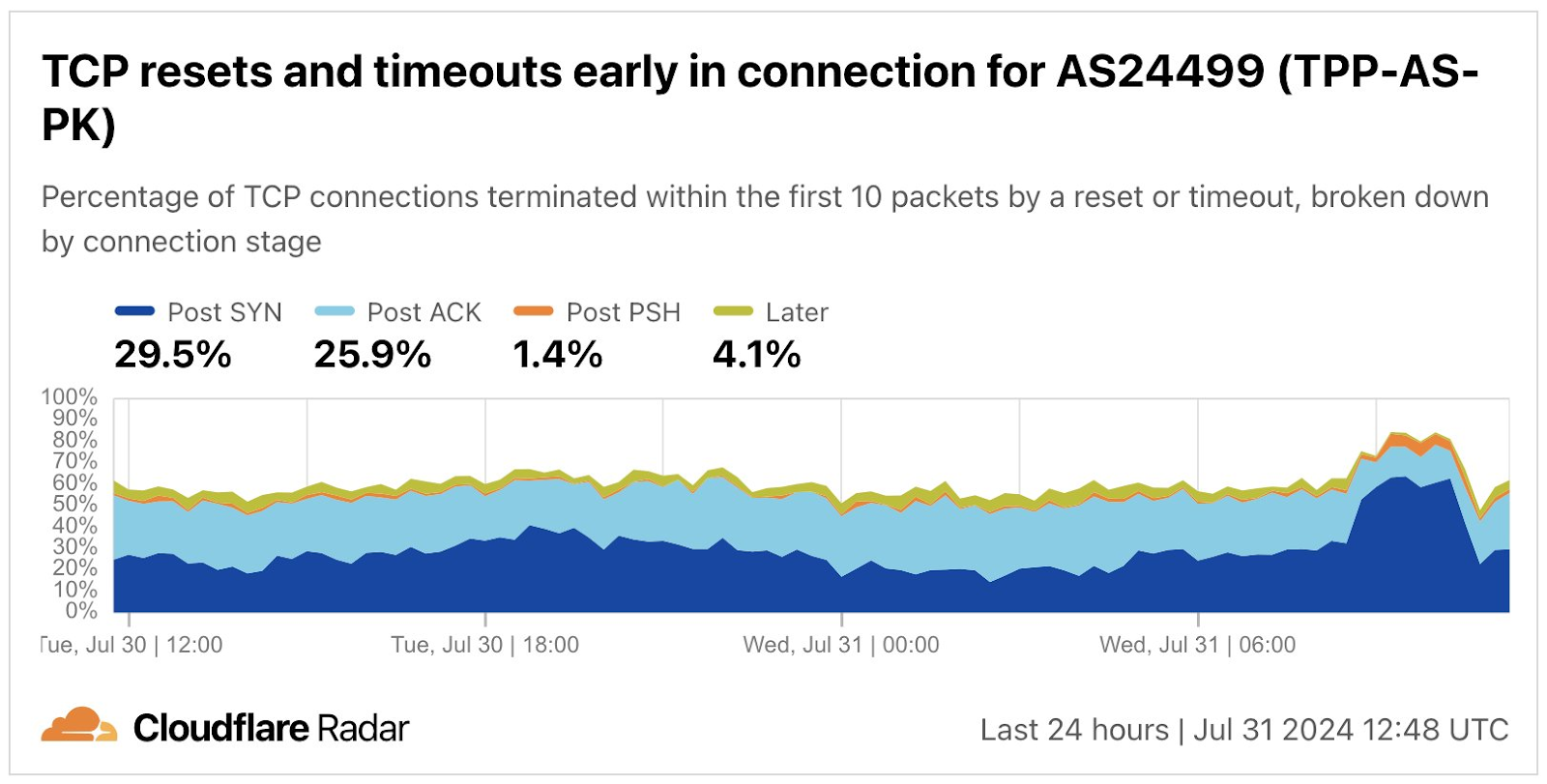
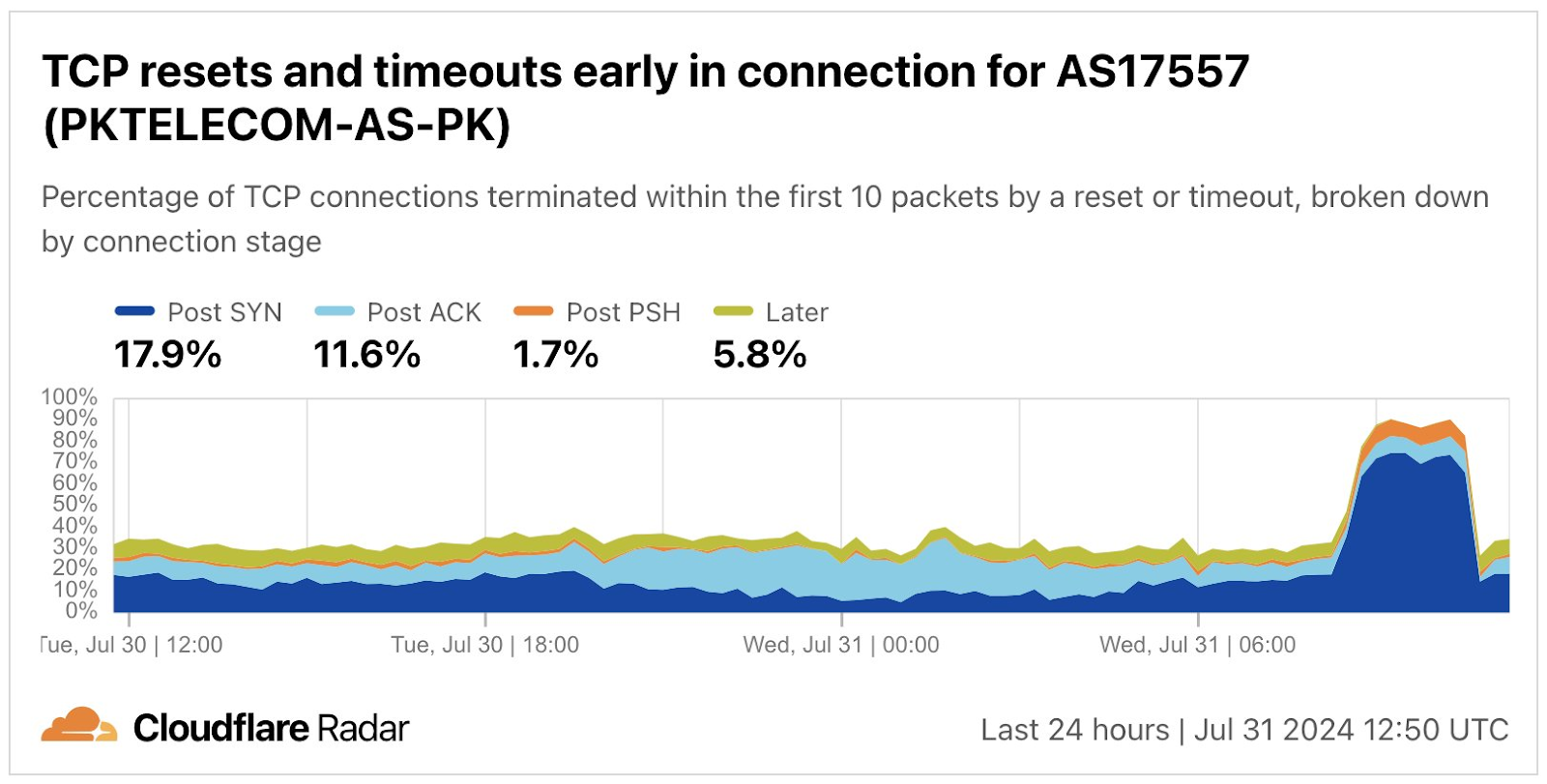
Regardless of the actual cause, the disruption had a clear impact on the country’s financial markets, with a published report stating “The KSE-100 index suffered a sharp decline on Wednesday, plummeting over 740 points in the final hour of trading amid a nationwide internet outage. Analysts attributed the sudden drop to panic selling as investors struggled with limited market data."
Venezuela
In the past, some countries have implemented government-directed Internet shutdowns as a means of limiting communication about or organizing of protests and demonstrations associated with contested elections. Although such protests and demonstrations sprang up in the wake of a contested presidential election in Venezuela that took place on July 28, Internet shutdowns did not follow. However, in monitoring Internet traffic in Venezuela during the days around the election, the Cloudflare Radar team did observe several notable drops in traffic, as compared to the same times the week prior.
After surging 35% at 05:00 local time (09:00 UTC) on Sunday, July 28 (election day), traffic dropped after the polls opened, down by as much as 23% at 09:00 local time (13:00 UTC). On July 29, the day following the election, traffic was as much as 28% lower than the same time the previous week at 06:15 local time (10:15 UTC) and 18:45 local time (22:45 UTC).

And while the observed drops in traffic appeared to be organic, and not caused by an Internet shutdown, it is worth noting that multiple websites are being blocked in Venezuela. An Internet Society Pulse blog post, published two days ahead of the election, reports that “Around 60 websites are currently blocked in Venezuela, including eight media sites and three that fact-check news and misinformation.”, citing data from the Open Observatory of Network Interference (OONI).
Conclusion
Visit Cloudflare Radar for additional insights around Internet disruptions, routing issues, Internet traffic trends, security and attacks, and Internet quality. Follow us on social media at @CloudflareRadar (X), noc.social/@cloudflareradar (Mastodon), and radar.cloudflare.com (Bluesky), or contact us via email.
Cloudflare's connectivity cloud protects entire corporate networks, helps customers build Internet-scale applications efficiently, accelerates any website or Internet application, wards off DDoS attacks, keeps hackers at bay, and can help you on your journey to Zero Trust.
Visit 1.1.1.1 from any device to get started with our free app that makes your Internet faster and safer.
To learn more about our mission to help build a better Internet, start here. If you're looking for a new career direction, check out our open positions.
